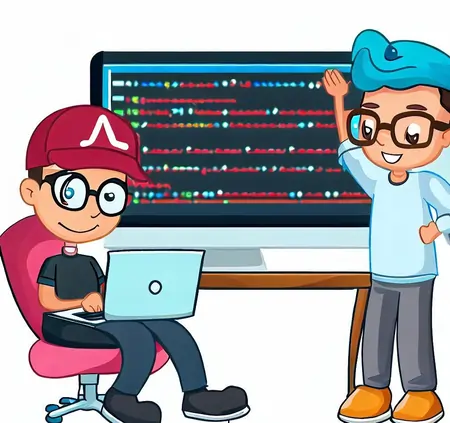Secrets Revealed: How Class Toppers Score High in R Programming Assignments

Do you have trouble getting excellent grades on your assignments involving R programming? Look nowhere else! In this blog, we reveal the techniques used by class leaders in R programming to achieve their success. In the fields of data science, machine learning, and statistical computing, R programming has emerged as a crucial tool. A solid grounding in programming principles, a comprehensive knowledge of the R language, and consistent practice are necessary for mastering R programming. You can improve your abilities, approach assignments effectively, and produce outstanding results in R programming assignments by adopting the techniques used by the class leaders, such as deconstructing complex problems, planning solutions, writing clean code, and thorough testing.
Learning R Programming: A Comprehensive Approach
Understanding R in-depth is the first step toward completing programming assignments. One of the most important skills you can develop in the field of data science is the ability to program in R, a statistical software language that is frequently used for data analysis. The features of the language, such as its graphical representations and statistical techniques, are frequently deeply understood by class leaders.

Understanding the syntax and grammatical structure of the language is essential for mastering R programming. Compared to other programming languages like C++, Python, or Java, R syntax is very different. Top performers pay close attention to understanding the distinctive features of R's syntax, such as the use of - for variable assignment and the distinct ways of calling functions. They are aware of the object-oriented and vector-based nature of the language, which influences how operations and functions interact with data in R. These minute variations might make the difference between passing your R programming assignments with passing grades and receiving outstanding ones.
Additionally, top performers are aware of the importance of different R programming data structures. When working with data in R, data structures like vectors, matrices, lists, data frames, and factors are essential. You will be able to handle challenging assignments with ease if you are skilled at manipulating these structures. For instance, when working with large datasets, knowing how to manipulate matrices and vectors can be very useful.
Developing Your Debugging and Error Handling Skills
The best R programmers don't just write code; they write code that is clear, reliable, and error-free. This ability is not naturally possessed. It develops gradually as a result of persistence and a thorough knowledge of the language. They devote a lot of time to learning how to debug their code and deal with errors.
R programming requires the ability to debug, which goes beyond just fixing syntax issues. Debugging entails finding logical mistakes, fixing the code so that it generates the right output, and ensuring that it functions correctly even with various data inputs. Top performers are familiar with the "debug" function in R, which offers a way to step through the code one line at a time.
Additionally, recognizing and handling R errors correctly can greatly enhance your overall performance on assignments. Errors, warnings, and messages are the three different types of conditions in R programming. Errors will stop your program from running, warnings will alert you to an unusual situation but won't stop the program, and messages are used by developers to provide crucial details about an active function or package. Top performers are well-equipped to anticipate and manage any potential issues in their code, which results in higher assignment scores because they have a thorough understanding of these conditions.
Data Visualization Talent
Effective data visualization skills are a defining trait of top-performing R programmers. Data scientists often say that a picture speaks a thousand words. Class leaders use these tools to differentiate their assignments thanks to R's impressive data visualization capabilities.
ggplot2, one of the main R packages for data visualization, is a part of the tidyverse package collection. It enables the creation of intricate and beautiful visualizations with comparatively easy syntax. Understanding ggplot2 necessitates knowledge of both the syntax and the layered grammar of graphics upon which it is based, in addition to the syntax itself.
High achievers will spend time learning this grammar. They are aware of the many ways that various geometric objects (germs), such as bars, points, and lines, can be used to represent various kinds of data. Additionally, they are aware of how to use aesthetic mappings to visually represent data variables through positioning, color, shape, or size. They are skilled at using facets to divide the data among various panels according to a variable, making comparisons simple. Additionally, they are skilled at theme modification, which enhances the plots' visual appeal in addition to their informational value.
Reproducibility and adequate documentation should come first
Last but not least, top performers stand out due to their emphasis on writing reproducible, well-documented code. Reproducibility in the context of R programming assignments refers to the capacity for another person (such as a teacher or a classmate) to use your R code and generate the same results. This is crucial in the field of data science because it frequently necessitates external validation and verification of results.
R code and the data you used to generate your results are typically required for reproducible code. Toppers make sure their data is readily available and in a format that R can easily load (such as a CSV or RData file). Additionally, they make sure that their R code is well-structured and contains all the steps required to replicate their findings, including loading the required libraries, preprocessing the data, and running the analysis.
Reproducibility is correlated with proper documentation. Top performers recognize the value of concise, clear comments in their code. Each component of their code is described along with its purpose and expected outcomes. They also effectively utilize R's built-in help system, using it to not only comprehend how functions operate but also to offer concise, understandable documentation for their unique functions. This dedication to reproducibility and documentation enables them to make sure that their work is simple to comprehend and reproduce, which improves assignment grades.
Understanding R's Packages and Libraries: R's Power Tools
Another trick used by top-performing students in R programming assignments is the array of R packages at their disposal. R packages are assemblages of data sets and functions created by the community. They improve the fundamental capabilities of R, simplifying difficult tasks and streamlining coding. Top students make it a point to comprehend and utilize these packages to their advantage in their assignments, as there are over 12,000 packages available in CRAN (Comprehensive R Archive Network) alone.
For instance, the tidyverse package collection's dplyr is a grammar of data manipulation, offering a standardized set of verbs to assist you in resolving the most frequent data manipulation problems. In a similar vein, ggplot2 enables simple yet sophisticated data visualization, and Shiny enables the creation of interactive web apps directly from R. High scorers are familiar with these and other significant R packages, including lubridate for date/time manipulation, a string for string manipulation, and caret for machine learning. They have an advantage in creating effective, efficient solutions for their assignments thanks to these power tools.
Accepting the Idea of Clean Data
Understanding and observing the principles of tidy data is a crucial component of successful R programming assignments. Hadley Wickham came up with this idea, which essentially says that standardizing data inputs makes code cleaner and makes it simpler to spot errors. Clean data
- Each parameter creates a column.
- Observations are arranged in rows.
- A table is formed by each variety of observational units.
High performers frequently reshape their data into this tidy format using the tidy package, ensuring that subsequent data manipulation, visualization, and modeling are as simple as possible. They decrease the possibility of errors and increase the readability and efficiency of their code by taking the time to prepare and organize their data.
Effective Coding Techniques
Toppers set themselves apart from competitors through their coding techniques. In R programming, solving a problem effectively is frequently more important than being able to do so. To summarize, this requires an understanding of vectorization, the use of suitable data structures, the preallocation of memory for large objects, and the avoidance of loops when possible.
Instead of looping through the values one at a time, vectorization involves applying a function or operation to the entire vector of values at once. This produces code that is cleaner and easier to read in addition to being more effective in terms of execution speed.
The effectiveness of the code can also be significantly improved by selecting the appropriate data structures. For instance, a data frame is typically a better option than a matrix or a list when working with tabular data. A character vector rather than a factor would be more appropriate if you were working with a string of characters.
Another important efficiency tactic is to pre-allocate memory. In R, it is more efficient to allocate all the memory you require for the object up front rather than letting R reallocate memory at each iteration of the loop if you are creating a large object by adding to it incrementally (such as in a loop).
Conclusion:
High scorers in R programming assignments have a habit of seeking out new information, which is ultimately their secret. Data science is a rapidly developing field, so staying on top requires ongoing learning and adaptation. Top performers don't just have to learn; they make it a habit.
They participate in discussions, ask questions, and share their knowledge frequently with the R community. You can learn more about R programming by visiting websites like StackOverflow, R-bloggers, and RStudio Community. Additionally, keeping up with the most recent advancements and industry best practices can be accomplished by following well-known data scientists and statisticians on social media sites like Twitter or LinkedIn.
Always keep in mind that mastering R programming is a journey that involves constant learning and development. So accept the challenge, have fun with it, and watch your assignment grades soar.